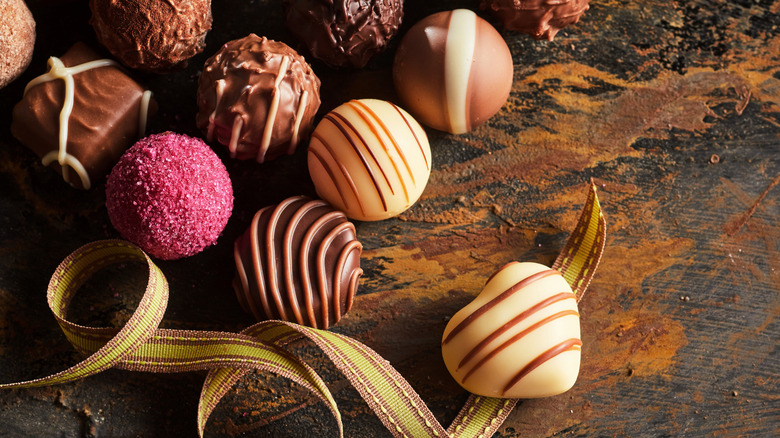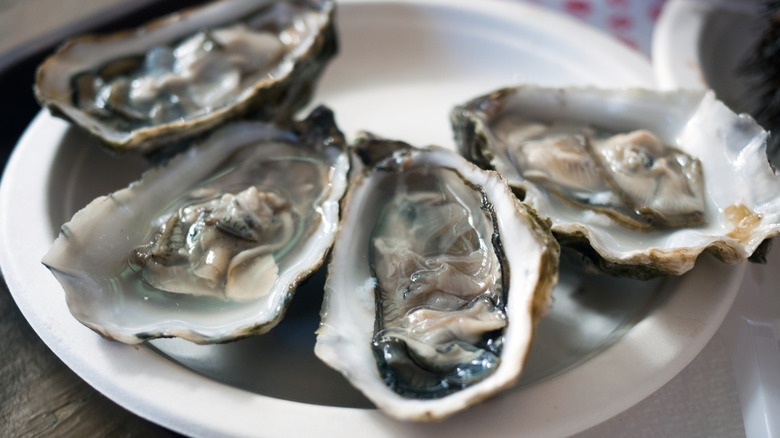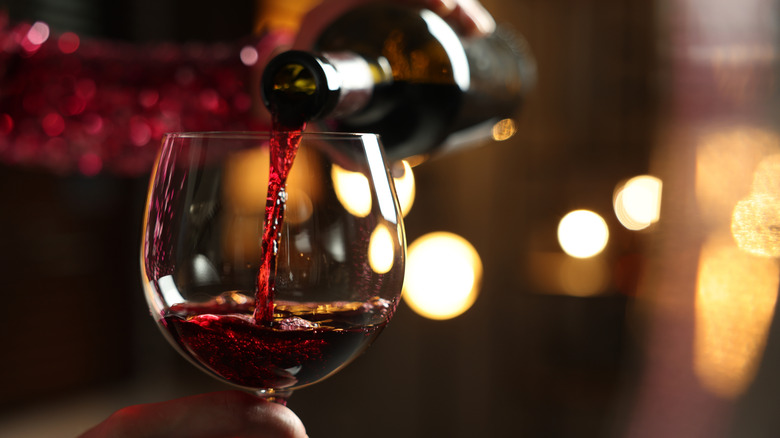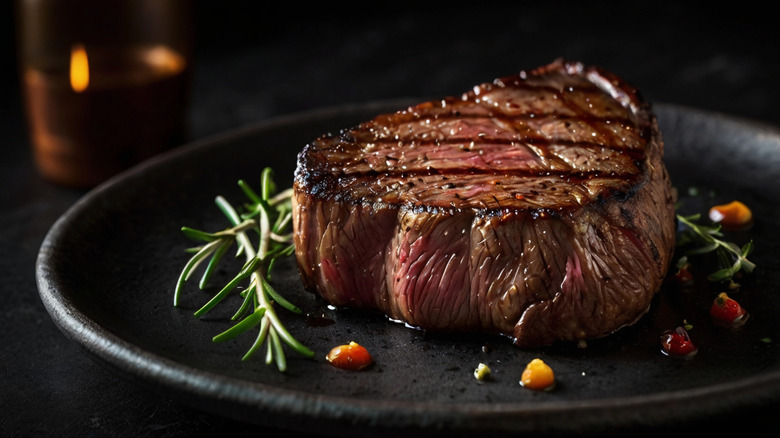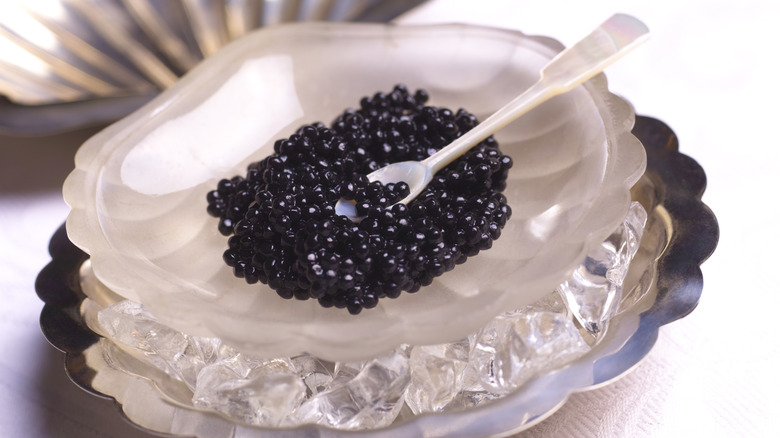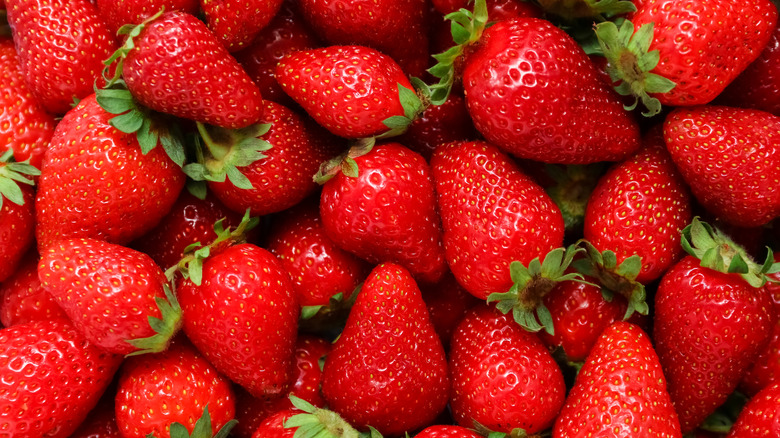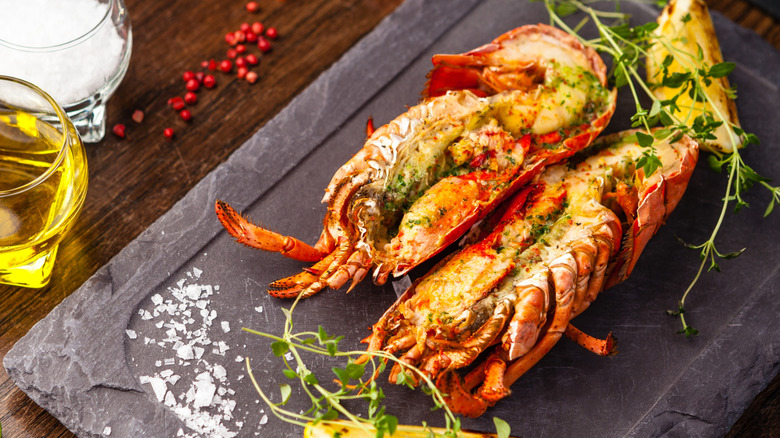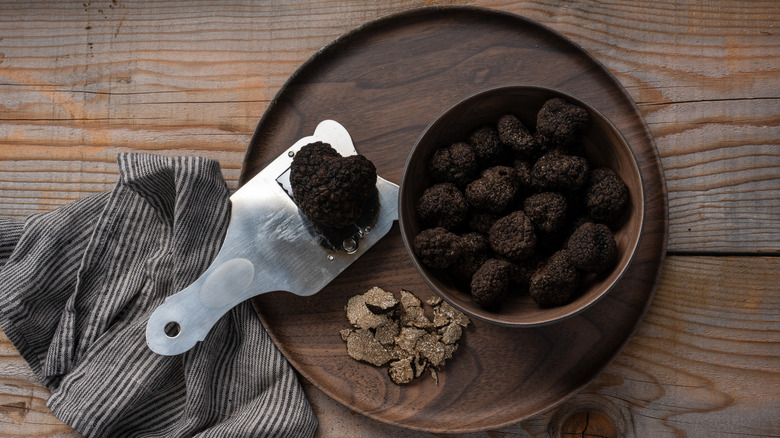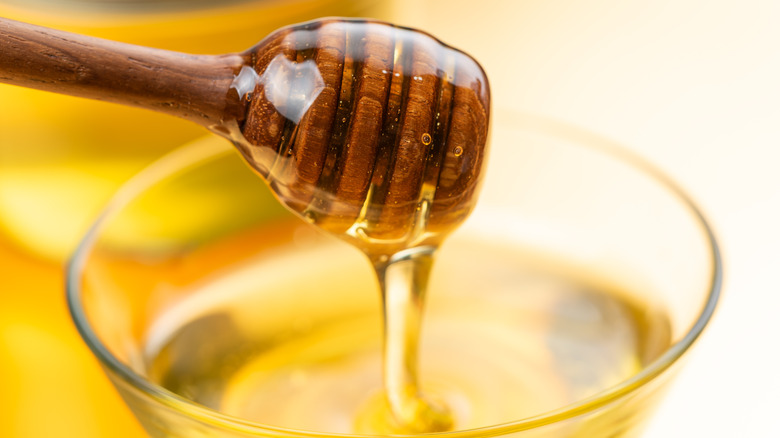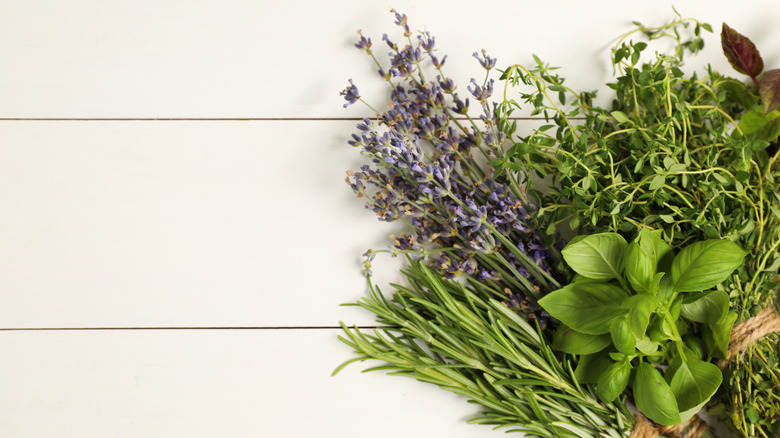What Makes These Traditional Valentine's Day Foods So Special?
From sweets to seafood, traditional Valentine's Day delicacies are wide-ranging. While we might not think twice about ordering a steak on February 14th or gifting a box of chocolates for the occasion, there's actually a lot of history and symbolism behind why certain foods are enjoyed on this day celebrating romance. Many of these dishes are deeply rooted in tradition, holding a special cultural place for their ties to love, fidelity, romance, and fertility. Some have become romantic go-tos for their aphrodisiac properties — both alleged and proven — while others remain staples because of their indulgent association with luxury.
The beauty of all traditional Valentine's foods is that they can either be enjoyed at a restaurant or prepared lovingly at home. In addition to what each of them represents, these dishes and their intrinsic link to this romantic holiday further symbolize how the stomach is one surefire way to the heart. Here are ten Valentine's Day foods that are among the most popular, and the reasons why we might consider sharing them with our special someone.
Chocolate
Valentine's chocolate is a tradition with a surprisingly long history, and forms of chocolate have been associated with love and romance since ancient times. An important ingredient in Mesoamerican society, cacao was used to make a beverage consumed during Aztec wedding ceremonies, which was also purportedly what fueled emperor Montezuma II's numerous affairs. While these elixirs were more on the bitter side, sweetened versions became popular across Europe once New World ingredients were introduced to the European continent.
Chocolate in liquid form was the dominant source of global cacao consumption prior to the 19th century. It wasn't until well into the 1800s that cocoa products for eating were introduced and popularized amongst consumers. This was when Cadbury, amongst other budding chocolatiers, capitalized on the romantic sentiments of the Victorian Era — a time when Valentine's Day celebrations were at their height. Cadbury had been a widely renowned chocolate maker for decades, but forever changed the celebration of romance from 1861 onwards with the introduction of heart-shaped chocolate boxes decorated with all manner of romantic symbolism. Thus began the marriage of chocolate and Valentine's Day, a pairing that has persisted ever since.
There may even be some science to back up why chocolate makes sense as a romantic gift. Dark chocolate contains mood-enhancing stimulants, which could be why it has been considered a potential aphrodisiac. A 2021 study, published by the journal Cureus, revealed that women had less interest in sex after consuming chocolate, suggesting it might have been an effective substitution.
Oysters
As creatures of the sea, oysters have something in common with Aphrodite. The Greek goddess of love was born from the ocean, and her name is the origin for the term aphrodisiac. As with many foods that have come to be deemed Valentine's classics, oysters' connection to the holiday lies with their alleged stimulating properties. While some of these effects may be more placebo than not — many claim these edible mollusks stir arousal simply for resembling genitalia — there are some nutrients found in oysters that might point to their consumption encouraging heightened feelings of desire.
Zinc is what makes oysters a potentially potent aphrodisiac, especially considering that they have higher zinc levels than any other food. This trace mineral is known to boost testosterone levels, an effect which has been observed in both men and women to potentially increase desire. While there isn't enough evidence to declare that oysters are a failsafe libido enhancement, legend and lore has popularized them to this effect. Giacomo Cassanova, the renowned Venetian lover of the 18th century, is purported to have fueled his amorous pursuits by consuming large quantities of oysters. Whether these were the true source of his success, however, is a matter of speculation.
Red wine
Wine is one of the more iconic elements of any Valentine's evening, and it has both historic and literary ties to the holiday. Served since ancient times for special festivities, notably including marriages in Ancient Greece, wine is also referenced in the early poetry that popularized Valentine's Day as an annual celebration. Chaucer's 14th century poem, "The Parliament of Foules," is widely considered the origin of this day as a romantic holiday, as it plays on the tradition of birds' mating season, traditionally thought to begin on February 14th. This poem mentions Venus, the Roman goddess of love, but also Bacchus, the Roman god of wine, continuing the tradition of consuming this revered drink during romantic festivities and directly linking it to February 14th as early as the 1300s.
Certainly these long standing connections between love and wine have contributed to the drink's necessity in contemporary Valentine's celebrations. Furthermore, wine is an expected accompaniment to other edible romantic staples, like steak and chocolate. In any case, a publication from the Journal of Clinical Medicine came to some conclusions that might account for wine being part and parcel to romance for millennia, finding that consuming red wine led to improved sexual function in both men and women.
Steak
Steak is another menu item that has become mysteriously inextricable with a traditional Valentine's dinner. As for how it turned into a classic, an association with luxury might be the only reason needed, paired with the fact that steak is often consumed with a glass of red wine. But there may be a fair bit of scientific evidence behind steak's popularity as a Valentine's meal, due to red meat's high zinc and vitamin B5 content. Research has shown that it might be another food that increases libido, making it both a luxurious and convenient main course for a romantic evening. There are a few creative ways to prepare a steak dinner too, which can be just as elegant as ordering at a nice restaurant.
Yet another reason steak might have become a Valentine's staple is in protest to the typically female-centric sweet treats omnipresent on this holiday. Tim Birdsey, a Boston radio host, proclaimed back in 2002 that steak should be the way to celebrate a male Valentine's Day (along with requisite sexual favors). While Birdsey's male-oriented holiday hasn't really taken off in popular culture, his emphasis on steak may have helped to further popularize the consumption of red meat on February 14th.
Caviar
There's little scientific evidence or physiological response to caviar which suggests that it might be another food with aphrodisiac properties. Contrarily, its consumption on Valentine's Day has largely arisen out of its inherent association with luxury. Though this delicacy was once considered a lower class snack, it rose to a status of exotic prestige in the 1920s. Today, caviar is something expensive, hard to come by, and traditionally consumed in moderation — even the smallest amount feels indulgent, especially when paired with champagne. This savory, luxury appetizer is inevitably considered a special occasion treat, making it an ideal accoutrement to many Valentine's Day meals.
As a seafood starter, caviar also makes for a natural prelude to other decadent seafood dishes that have become Valentine's staples, such as oysters and lobster. Whether diners are first-time caviar consumers or seasoned veterans, this gourmet specialty is simple, elegant, and always sure to impress.
Strawberries
Legends state that strawberries were long ago seen as one of nature's symbols for Venus. As a sweet, succulent fruit, their vague heart shape and deep red color make this easy to imagine and go along with. But strawberries didn't really resemble the lusciously sized fruit they are today. Thanks to Chilean white strawberries and some French espionage that brought this paler variety to Europe in the 1700s, horticulturalists were able to hybridize numerous strawberry species, selecting for size and color to create the delicious berries we know, crave, and enjoy today.
Contemporary culture has continued to emphasize the connection between strawberries and romance. Though February is not necessarily the most ideal season for eating strawberries — they're an early summer fruit and thus at their best later in the year — they pop up surrounding Valentine's Day in numerous forms, most famously dipped in chocolate. Chocolate covered strawberries are a fairly recent innovation, but the fruit's alleged Venus symbolism mixed with stimulating cacao adds in the Aphrodite factor, representing two iterations of the same goddess of love that meld into an ultimate and timeless romantic delicacy.
Lobster
Once considered an undesirable by-catch, lobster has been regarded since the mid 19th century as one of the most high-end luxury items available on any seafood menu. An elegant choice, even if it may be slightly difficult to eat gracefully, the lobster has also garnered a well-established romantic reputation. On the one hand, lobster's zinc and B vitamin content has prompted many to believe it has an effect on the libido — many state that the Maine lobster is an all-American aphrodisiac. But the crustacean has more sentimental ties to romance as well.
Until recently, it was widely believed that lobsters were among a handful of romantic creatures (like swans and seahorses) that mate for life, a factoid popularized in the television sitcom, "Friends." Though this has since been disproven, lore and legend has kept the myth alive. Little can be said for what it means to eat a possibly monogamous creature on a holiday with romantic undertones, but the symbolism remains, and lobster in every form imaginable is today a popular Valentine's dinner choice in restaurants all over. If successfully avoiding the typical cooking mistakes, it can be an equally elegant homemade romantic dinner too.
Truffles
Not to be confused with the chocolate ganache-filled confections that go by the same name, natural truffles, the edible mushroom that grows underground, have joined the ranks of savory Valentine's treats. Rare, expensive, succulent, and the crowning accoutrement to many dishes, truffles function as a microcosm for mating rituals, as they exude their own chemicals for attraction in order to reproduce.
A biologist explained this phenomenon very succinctly for the Stanford Report, describing how truffles release their own naturally enticing odors in order to tempt animals into seeking them out and digging them up. One of these fungal pheromones is androstenone, both a sex hormone for wild boars and an element found in human sweat. This is what attracts mammals to subterranean truffles and what also leads many to believe that there is a sensual connection between humans and these elegant fungi too. Whether or not they are a true aphrodisiac is still up for debate, but using them when cooking provides a dash of indulgence that makes any dish a little bit sexier.
Honey
Honey is another food that has ancient associations with love and fertility. In Roman mythology, Cupid's arrows were dipped in honey before being used for his instantaneous matchmaking. For a more practical application, honey was also used as an aphrodisiac in the days of ancient Greece — Hippocrates was known to prescribe it to his patients facing fertility issues for this very reason. In our contemporary culture, honey still has close ties with romance, used as a term of endearment and also in reference to the act of marriage itself, after which honeymoons remain a widespread tradition.
Further links between honey and Valentine's Day are with Saint Valentine himself, who was a devoted beekeeper and has become one of the patron saints of bees. While this mortal ambrosia has more historic ties with romance than contemporary applications, honey has one more attribute that makes it fitting for Valentine's Day — the immortal comparison that it is, like love, delectably sweet.
Basil, Lavender, and Rosemary
Roses may be a more widely recognized element of any Valentine's bunch of flowers, but there are a handful of herbs which also carry romantic symbolism worthy of a bouquet. The three most significant on this list are lavender, rosemary, and basil. Studies have shown that lavender acts as a bonafide aphrodisiac, with its consumption leading to improved sexual desire. Though there's less definite evidence towards the same effects in rosemary and basil, these other two herbs have historically been believed to promote desire as well, and have long since symbolized other aspects of enduring love. Rosemary was an important element in medieval wedding bouquets, representing remembrance as a reminder of the fidelity pledged through wedding vows. Basil was associated with hatred in ancient times, but this passion has evolved over the centuries to be regarded as a symbol of love, particularly in Italy.
Attributing emotional symbolism to plants may not be as mainstream today as it once was within ancient mythologies and the Victorian language of flowers, but these three herbs are easy to incorporate into Valentine's celebrations for a touch of tradition. They make for added ambiance in the form of essential oils, but can be even more easily included as seasoning in home prepared meals.

